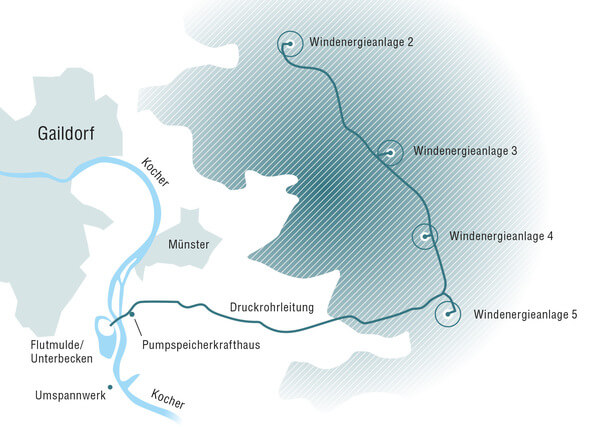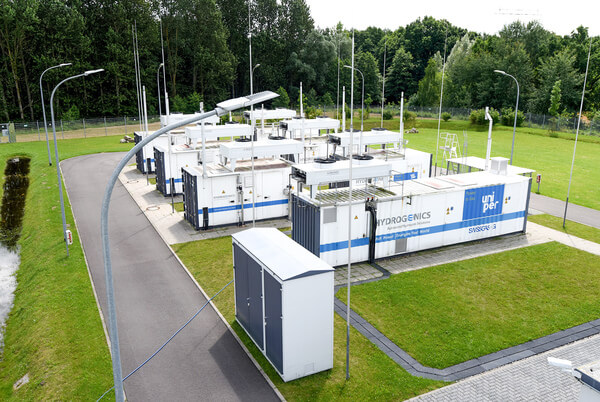News Release from windfair.net
Wind Industry Profile of
Germany: Experimenting On Energy Transition
The next decisive step in the course of energy transition is the development of appropriate storage methods for production surpluses from renewable energies. Especially in Germany, where the transition to renewable energy is already well advanced, research is focusing on storage methods and ways to link different renewable energy sources as well as the use of sector coupling.
Natural energy storage in Gaildorf
A new method will be tested soon in Gaildorf in southwest Germany. At the end of 2018, a natural energy storage facility is to be connected to the grid. It is a flexibel power plant that combines wind and water power for the first time. A wind farm is combined with a pumped storage power plant, resulting in a large water-based battery. This will serve as a short-term storage facility and will keep the electricity grid stable in the future.

The river Kocher flows through the village of Gaildorf, to the east of which lies the mountain range of the Limpur mountains, on which the four wind turbines will be installed. (Image: Naturspeicher GmbH)
Swiss company ABB is supplying three medium-voltage wind turbine converters PCS6000 as well as three high-voltage asynchronous motors AMI800, the transformers and the switchgear to the facility in Gaildorf. This makes the natural energy storage facility infinitely variable and can provide control energy very efficiently.
"In comparison to conventional converters, wind converters meet the network operators' grid code requirements and are thus ideally suited for this type of application," says Stefan Bögl, Managing Director of Naturspeicher GmbH. "For the first time, a series product from the wind energy market is introduced into the hydroelectric power market, which otherwise only works with individually designed products."
Power-to-gas and a methanation plant in Falkenhagen
Another, more long-term solution is sought in Falkenhagen in Brandenburg. There, Uniper, a subsidiary of German utility E.ON, already operates a power-to-gas plant. According to the principle of electrolysis, the pilot plant converts wind energy into hydrogen, from which a small fraction of pure hydrogen, so-called "wind gas", is fed directly into the natural gas grid.

Power-to-gas plant in Falkenhagen (Image: Deutscher Verein des Gas- und Wasserfaches e.V. (DVGW) / Uniper)
The existing plant will now be expanded by a methanation plant, which also converts hydrogen into methane using CO2. This methane is synthetic natural gas, which can be transported and stored in the existing natural gas infrastructure from storage and pipelines without restriction. As a result, wind energy can be stored in the natural gas grid to decouple production and consumption. The heat generated during the conversion is also made available to a nearby veneer plant as a way of sector coupling.
In the project, various partners are working together with EU financial support: Uniper is setting up and operating the new plant together with thyssenkrupp Industrial Solutions, the German Technical and Scientific Association for Gas and Water (DVGW) and the Karlsruhe Institute of Technology (KIT).
"Power-to-gas is one of the key technologies for the energy transition. In Falkenhagen, we have developed this technology to market maturity. Green gas is generated from renewable energy, which can also be used in a wide variety of ways – also through the possibility of methanation. However, the large-scale deployment is currently hampered by inadequate political conditions. The role of storage technologies must be taken into account so that the necessary integration of renewables through power-to-gas will soon take place," said Eckhardt Rümmler, who is responsible for innovations on the Uniper board.
Greenpeace Energy calls on federal government to act
Renewable energy supplier Greenpeace Energy also operates a power-to-gas plant in Germany and sells wind gas to its customers. Their CEO is also dissatisfied with the current political conditions and warns of the dangers of extreme weather conditions.
A recent study commissioned by Greenpeace Energy by Berlin research institute Energy Brainpool, has investigated the so-called 'dark doldrums' ('kalte Dunkelflaute' in German). It is the time of winter when wind and solar power plants produce too little electricity due to weak winds, strong cloudiness, and darkness over several days or weeks in order to meet the high demand of electricity which is simultaneously caused by the cold.
"The plans of the Federal Ministry of Economics are not enough. The energy system also needs sustainable technological solutions for sustainable supply, "says Sönke Tangermann, CEO of Greenpeace Energy. According to the study, this is only possible thanks to the large-scale use of innovative technologies such as wind gas.
The Federal Ministry of Economics, on the other hand, had emphasized in its strategy paper "Electricity 2030" that the supply of electricity in the future should be secured by imports from neighboring countries. However, the recent study shows that the cold dark days often affect large parts of Europe at the same time. On the other hand, only an expansion of the new technologies abroad would help solve the current problem. "With a pan-European energy demand, the cross-border exchange of electricity in the coming years will have to be complemented by additional flexibility options in order to cushion weather events such as the dark doldrums," says Fabian Huneke of Energy Brainpool.
Ultimately, everything goes even further to an even greater diversification of the energy market. Versatile methods of renewable energy use and storage must be reconciled by a variety of players to create a carbon-free power system as quickly as possible. The next stage of the energy transition has only just begun.
- Author:
- Katrin Radtke
- Email:
- press@windfair.net
